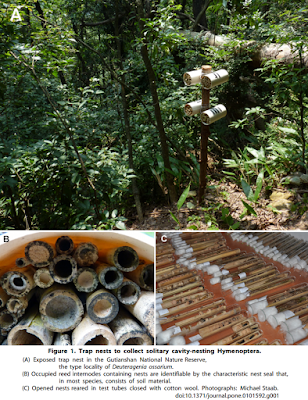Abstract
Hymenoptera show a great variation in reproductive potential and nesting behavior, from thousands of eggs in sawflies to just a dozen in nest-provisioning wasps. Reduction in reproductive potential in evolutionary derived Hymenoptera is often facilitated by advanced behavioral mechanisms and nesting strategies. Here we describe a surprising nesting behavior that was previously unknown in the entire animal kingdom: the use of a vestibular cell filled with dead ants in a new spider wasp (Hymenoptera: Pompilidae) species collected with trap nests in South-East China. We scientifically describe the ‘Bone-house Wasp’ as Deuteragenia ossarium sp. nov., named after graveyard bone-houses or ossuaries. We show that D. ossarium nests are less vulnerable to natural enemies than nests of other sympatric trap-nesting wasps, suggesting an effective nest protection strategy, most likely by utilizing chemical cues emanating from the dead ants.
 |
| Figure 1. Trap nests to collect solitary cavity-nesting Hymenoptera. (A) Exposed trap nest in the Gutianshan National Nature Reserve, the type locality of Deuteragenia ossarium. (B) Occupied reed internodes containing nests are identifiable by the characteristic nest seal that, in most species, consists of soil material. (C) Opened nests reared in test tubes closed with cotton wool.
Photographs: Michael Staab. || doi: 10.1371/journal.pone.0101592.g001
|
Etymology: The new species is named after the Latin ‘ossarium’, which means bone-house or ossuary. An ‘ossarium’ is a covered site, where human remains are deposited. The species name is an allusion to the unusual nesting strategy of the new species, which closes the nest with a vestibular cell filled with dead ants. This reminds us of historical bone-houses in monasteries and graveyards, which over time were filled with piles of human bones. The new name is a noun in apposition.
Suggested common name: As a common name for D. ossarium we suggest in reference to its biology the use of ‘Bone-house Wasp’.
Distribution: Known only from South-East China.
Michael Staab, Michael Ohl, Chao-Dong Zhu and Alexandra-Maria Klein. 2014.
A Unique Nest-Protection Strategy in a New Species of Spider Wasp.
PLoS ONE. DOI: 10.1371/journal.pone.0101592
A Unique Nest-Protection Strategy in a New Species of Spider Wasp.
PLoS ONE. DOI: 10.1371/journal.pone.0101592

